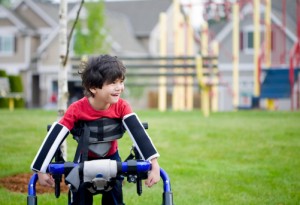 Cerebral palsy is a developmental condition that is non-progressive. Cerebral palsy results in physical disability and developmental disorders, and there is no cure. There are three different categories of cerebral palsy: spastic, ataxic and athetoid, with 80 percent of cerebral palsy cases being of the spastic variety. Read on for more information regarding cerebral palsy, the quality of life for these patients, and the prognosis.
Cerebral palsy is a developmental condition that is non-progressive. Cerebral palsy results in physical disability and developmental disorders, and there is no cure. There are three different categories of cerebral palsy: spastic, ataxic and athetoid, with 80 percent of cerebral palsy cases being of the spastic variety. Read on for more information regarding cerebral palsy, the quality of life for these patients, and the prognosis.
What Causes Cerebral Palsy?
Cerebral palsy is a condition that results from damage to the area of the brain that is responsible for motor control. This condition can be a result of many different factors. The damage can be caused from exposure to radiation or an infection during the mother’s pregnancy, and can affect intrauterine development. Cerebral palsy can also result from asphyxia, hypoxia, and birth injuries. For example, the misuse of forceps during delivery or a doctor’s failure to notice fetal distress can result in cerebral palsy, and is medical malpractice. Cerebral palsy can be unavoidable, or it can be the result of medical malpractice.
The risk of cerebral palsy increases with multiple births, and 40 to 50 percent of cerebral palsy cases are from premature births.
What is the Quality of Life Like for a Cerebral Palsy Patient?
Because cerebral palsy has a spectrum of symptoms, the quality of life differs depending on the patient’s symptoms. Common symptoms across the three subtypes of cerebral palsy include, but are not limited to: joint and bone deformities, limited movement, muscle spasms and abnormal muscle tone. Additional symptoms that might not necessarily affect all cerebral palsy patients include: epilepsy, communication disorders, mental retardation, learning disabilities and urinary incontinence. It is not uncommon for cerebral palsy patients to also suffer from chronic sleep disorders.
Of course, a patient’s quality of life will be affected depending on the symptoms they present. Generally speaking though, cerebral palsy patients are able to live a fulfilling life with the help of different therapies, and with the aid of a caregiver. Massage therapy is recommended to alleviate pain associated with tightened and shortened muscles caused by cerebral palsy. Speech therapy is recommended to increase a patient’s ability to communicate, and therefore increase their quality of life as an adult.
Additional therapies to improve a cerebral palsy patient’s quality of life include physiotherapy, occupational therapy, braces, drugs for any pain, and Botox to relax contracted muscles.
What is the Prognosis?
Cerebral palsy patients can expect to live a full life and have a normal life expectancy. Living conditions do vary though, as well as how independent the patient will be in adulthood. Cerebral palsy is not inherited, meaning independent cerebral palsy patients can reproduce if they desire and have a healthy family.
Having a child with cerebral palsy can put a lot of strain on a family, both in terms of the therapies required and the cost. In fact, the cost of therapy throughout a cerebral palsy patient’s life is estimated to cost over $921,000. Even though there is no cure, individuals with cerebral palsy can enjoy a full, normal life with the help of all the different therapies available.
If you or a loved one has been diagnosed with cerebral palsy and you believe it is the result of medical malpractice, speak with a lawyer to see if you have a case. Janet, Jenner & Suggs, LLC is a law firm with experience advocating for the victims of cerebral palsy injuries nationwide. For more information about cerebral palsy injuries, visit the website at www.Cerebral-Palsy-Injury.com.
Andrew Miller
Latest posts by Andrew Miller (see all)
- Make Room for Motorcycles - December 20, 2013
- Making Safety a #1 Priority at Your Rental Property - December 17, 2013
- 3 Fun Team-building Activities Outside of Work - November 18, 2013
